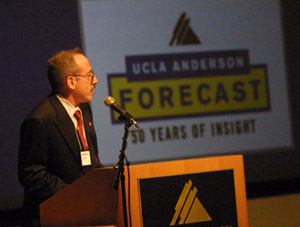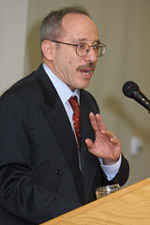|
 |
The New World Of Real Estate
|
David Shulman
December 5, 2001
|
A talk delivered before the UCLA Anderson Forecast on December 5, 2001.
 My task tonight is to spend a few minutes with you to discuss what I perceive to be the
new world of real estate. To be sure, much of the old world is still with us and I will
highlight several notable features of the old world that will still be with us in the
coming years. Moreover my focus will be much more on commercial rather than residential
real estate.
My task tonight is to spend a few minutes with you to discuss what I perceive to be the
new world of real estate. To be sure, much of the old world is still with us and I will
highlight several notable features of the old world that will still be with us in the
coming years. Moreover my focus will be much more on commercial rather than residential
real estate.
Now to the task. First in outline form there are six new features that I believe to be
new and possibly a seventh. They are:
Commercial real estate is and probably will play a smaller role in the business cycle
than in the past. Instead of being the main event, it will be more of a sideshow.
The 1995-2000 economy was not "normal” and therefore extrapolations into the future are
unlikely to be validated.
Inflation and/or a cyclical recovery in asset prices will not bail out poor investment
decisions.
September 11th gave new meaning to the term "disaster recovery".
Should terrorism become more of part of daily fabric of our lives, much agglomeration
economies we rely on will fall by the wayside.
The recent collapse in retailer margins may very well have profound effects on
retail-oriented real estate.
The full consequences of the 1996 tax cut affecting capital gains from owner occupied
residences have yet to be fully played out.
Now let me amplify some of the points I just made. Unlike the 1990-91 and the 1974-75
recessions, the current downturn in commercial real estate is more a result of declining
aggregate demand rather than that of a severe over-supply. Put bluntly, the real estate
industry did not screw up too badly this cycle. The irrational exuberance took place in
other sectors of the economy. I suspect that the greater dissemination of micro real
estate market information has made over-building less likely in the future.
It is not a guarantee, because as we have seen the existence of public companies in
telecommunications certainly did not prevent the vast over building of that sector or the
economy. Nevertheless real estate does not have the sizzle of technology making it les
likely to get over-enthusiastic. We only have to look at the once white-hot San
Francisco Bay real estate market, where lenders did not ratify the spike in commercial
rents thereby mitigating a potential debt deflation.
The technology/financial services boom of 1995-2000 concentrated real estate activity in
four cities. The financial services trifecta of Boston, New York and San Francisco, and
the technology trifecta of Boston, Washington D.C. and San Francisco(broadly defined)
dominated commercial real estate in the late 1990s. Of course other cities such as
Seattle, Austin, Los Angeles, Dallas and Atlanta benefited, but the real action took
place in Boston, New York, Washington D.C. and San Francisco. Going forward, I suspect
that growth will be more democratic which would tend to favor some of the lower cost
alternatives. The major cities in Texas will pose a very strong challenge in this
regard. When revenues and profits weren't relevant, and access to capital was, then the
obvious choice was to locate closed to capital. Now that profits matter, more mundane
considerations, such as the cost of doing business, come to the fore.
 Over the past 50 years, real estate investors have traditionally been bailed out either
by inflation, and/or a cyclical recovery in asset prices. Because inflation is likely to
remain low and there is an absence of distress in the real estate market, it appears to
me that its going to be much harder to make a buck going forward than in the past. At
least for now, it is hard to see extraordinary returns coming from commercial real
estate. This goes back to my first point that the current real estate cycle is different
from the past.
Over the past 50 years, real estate investors have traditionally been bailed out either
by inflation, and/or a cyclical recovery in asset prices. Because inflation is likely to
remain low and there is an absence of distress in the real estate market, it appears to
me that its going to be much harder to make a buck going forward than in the past. At
least for now, it is hard to see extraordinary returns coming from commercial real
estate. This goes back to my first point that the current real estate cycle is different
from the past.
September 11th gave new meaning to the "disaster recovery". All too many financial
services companies discovered that having disaster recovery sites on the same
telecommunications and power grids did not work. The firms that functioned well after
September 11th had their disaster recovery sites in New Jersey, not a few blocks away in
lower Manhattan. It is for this reason that Morgan Stanley sold their new midtown
building to Lehman Brothers. Morgan Stanley's new building was just two blocks away from
their headquarters.
Thus should the fear of terrorism become more pervasive, sprawl rather than concentration,
would become the order of the day. Few people would want to work in a building or a
business district with big bulls-eye on it. That would have the effect of undoing much of
the agglomeration economies associated with firms and divisions of the same firm
clustering together. In that environment a 300,000 square foot, non-descript suburban
office building might be more attractive to tenants than a glitzy three million square
foot urban mixed-use project. When looked at this way terrorism has the potential to
exact a very high tax on productivity.
Almost unnoticed amidst the dramatic decline in the general profitability of American
business has been the severe erosion of specialty retailer profit margins. In the more
extreme case of Gap Stores, since 1999 gross margin has declined from 45.5% to an
estimated 37% this year and more critically its operating margin has declined from 19% to
8.6% over the same time period. Put it very bluntly should this contraction be more
secular rather than cyclical in nature, regional malls would witness a combination of
declining occupancy and rents. It is still too early to tell, but my recent visit to my
local regional mall was hardly encouraging.
Finally to talk about residential housing, the full consequences of the $500,000
exemption from capital gains taxes derived from sales of owner occupied housing are only
beginning to be worked out. Prior to 1996 homeowners had to continually trade-up to
defer capital gains taxes. Now they don't and that means the sale of one expensive house
can give rise to the demand for two new housing units. How so? The homeowner can sell
their existing large home and buy a condominium or rent an apartment in their current
area and then buy another home in more of a resort/retirement area. For example a New
Jersey household sells their home and buys a condominium in either Manhattan or New
Jersey and also buys a vacation home in say, South Carolina with the proceeds. You can
obviously make a similar analogy for West Los Angeles. In the past the Homeowner would
be forced to trade-up and buy a much bigger vacation home or stay put.
|
What Will Remain the Same
|
Despite all of the talk in recent years about "smart growth" and urban revival, the
fundamental pattern of settlement remains sprawl. Although it is hard to be against
something called "smart” and implicitly be for something called dumb, sprawl isn't such a
bad thing. Indeed "smart growth" is difficult to put into practice in dense urban areas.
Witness the problems your local Playa Vista project is having with its neighbors. At
the end of the day, sprawl is responsible for keeping housing on a national basis
affordable and deserves at least some of the credit for the nation's record high home
ownership rate. In the 1990s in every major metropolitan area population growth in the
suburbs swamped that of their respective central cities. I expect that trend to
continue.
Nevertheless cities in conjunction with their suburbs will remain the locus of
intermediating trade, culture and ideas as long as public safety is not threatened. The
crack cocaine epidemic of 1984-1993 did more to undermine the central city than all if
the suburban subdivisions of that era. Thus as long as public safety is not on the fron
tburner as political issue, cities would, at least, have a chance to thrive. Thus it is
no accident that Manhattan, for example thrived in the 1990's and it is at risk should
high profile terrorism become more than a one-off event.
Similarly the post World War II trend of having U.S. population move south and west will
continue. In 1990s the suburbs of New York, Cleveland, Philadelphia, Boston, Detroit and
St. Louis witnessed a population growth of less than 10%. In contrast the suburbs of
Dallas, Houston, Atlanta, Miami, Seattle, Phoenix and Denver had a population increase in
excess of 20%. Interestingly, because of the early 1990 aerospace-based contraction and
other factors, population growth in California was limited in the 1990s. Nevertheless
because of the state's openness to new ideas, it will remain one of the growth magnets in
the Nation.
Finally immigration will continue to be a major driver of real estate demand. In the
beginning of the 1990s most economists forecast that underlying housing demand in the
1990s would generate about 11-13 million new housing starts. We ended up with 14 million
starts and a good part of that increase in demand was due to the arrival of 11 million
immigrants. Although the Administration's pro-immigration program is now on the back
burner, I suspect that despite the current terrorist threat the U.S. will remain open to
new immigrants.
|
|
|

